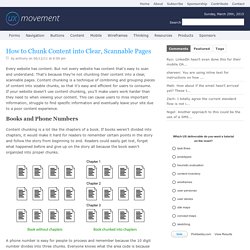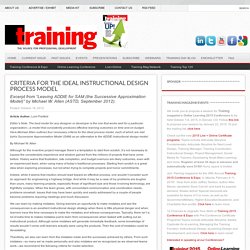

7 Principles of Universal Design. Considering the User Perspective - A Summary of Design Issues. How to Chunk Content into Clear, Scannable Pages. By anthony on 06/12/11 at 8:00 pm Every website has content.

But not every website has content that’s easy to scan and understand. Tom Wujec: 3 ways the brain creates meaning. How to Create Learning Objectives. One of the biggest challenges in course design is creating a course consistent with the organization’s learning objectives.

Often courses are built around fuzzy objectives where the expected outcome isn’t quite clear. Another issue is that the course doesn’t end up meeting the objectives. Learning Objectives Require Clear Goals Why is the course being built? Verbs for Learning Outcomes. More verbs for learning outcomes. Bloom's Taxonomy Action Verbs. On the changing nature of learning context. ASTC - Resource Center - Education - Learning: Theory and Practice - Learning in Context. Learning in Context by Laura Martin Why talk about context?

My experiences as a grade school teacher in the 1970s made me curious about children’s thinking. I decided to attend a graduate program in developmental psychology so I could study why children thought the way they did. I was already familiar with Piaget and had seen real-life evidence supporting his theory. Once I watched a first grader at a school fair paying for a nickel item with a quarter and getting two dimes back as change. In graduate school, one study was presented to us as a significant breakthrough,a 1948 study of children’s memory by Z.M. Since the mid-70s many scholars of cognitive functioning and development have criticized standard laboratory studies of cognitive performance.
The approach I adopt in understanding thinking outside of school is an activity theory, or sociocultural, approach to cognitive development. One important insight that came out of this work deals with goals and motivational settings. Learning Styles Concepts and Evidence Pashler. Can i use this picture? ADDIE Model Explained. Anyone who is actively involved with instructional design has at some point used the ADDIE model (Analyze, Design, Develop, Implement, and Evaluate) for their course development.

This model is one of (if not the) most popular structures used by training designers today. As you can expect, it has received a lot of attention from the community – some criticizing it, others providing praise. Personally, I feel that ADDIE works just fine, and I have used a variation of it for years on my own projects. It’s actually quite interesting how passionate people are one way or another when it comes to this model. I think if you approach any training design and implementation with an understanding that it will have its own unique qualities, then you allow for a flexibility within the model road-map. I suppose what I find missing from the method is a TESTING component – or, a dry-run after development. Criteria for the Ideal Instructional Design Process Model. Editor’s Note: The best model for any designer or developer is the one that works well for a particular organization—a model that consistently produces effective learning outcomes on time and on budget.

Here,Michael Allen outlines four necessary criteria for the ideal process model, each of which are met byhis Successive Approximation Model (SAM) as an alternative to the ADDIE instructional design model. By Michael W. Allen Although for the inventive project manager there’s a temptation to start from scratch, it’s not necessary to bypass the considerable experience and wisdom gained from the millions of projects that have come before.
History warns that frustration, late completion, and budget overruns are likely outcomes, even with an experienced team, when using many of today’s traditional processes. Indeed, while it seems that intuition should lead toward an effective process, one wouldn’t consider such an approach for engineering a highway bridge. We can learn by making mistakes. 4 CRITERIA FOR IDEAL ID PROCESS MODEL. Firstprinciplesbymerrill. Phases of Effective Instruction. Understanding by Design Chapter 1 Backward Design. Backward design. What Do ID's Do? Tips For IDN525. Lecture: ID as a Career. 10 Super Powers of the World’s Greatest Instructional Designer. Any professional eLearning designer would agree that users are always at the heart of what they do.

The bulk of our articles last year focused on users. But what about designers themselves? Who are they? What impressive feats do they perform? What skills do they possess? That’s why we’re going to start the year with this quick list of super powers every excellent instructional designer has: 1. Instructional designers share a passion for learning. They constantly seek new topics to learn and teach, no matter which area or industry. 2. Non-professionals might have an idea of how people learn. In sum, they design for how people learn. History of Instructional Design and Technology. WhatisID.